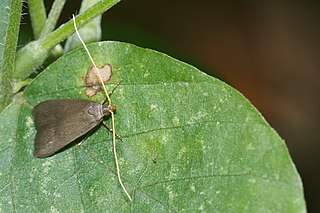The persona designata doctrine is a doctrine in law, particularly in Canadian and Australian constitutional law which states that, although it is generally impermissible for a federal judge to exercise non-judicial power, it is permissible for a judge to do so if the power has been conferred on the judge personally, as opposed to powers having been conferred on the court. The doctrine in the more general sense has been recognised throughout the common law countries. Persona designata, according to Black's Law Dictionary, means "A person considered as an individual rather than as a member of a class"; thus it may be a person specifically named or identified in a lawsuit, as opposed to the one belonging to an identified category or group. While it has its origin in Montesquieu's doctrine of the separation of powers, it can be traced back as far as Aristotle's Politics.

The Lecithocerinae are a subfamily of small moths in the family Lecithoceridae. They are found worldwide, but most species occur in South Asia. The subfamily is characterized by the male genitalia with a bridge-like structure connecting the tegumen and the valva, and the uncus almost always is vestigal with two lobes at the dorsal base, only exceptionally united into a broad plate, but never as a thorn or spine.

Xanthorhoe designata, the flame carpet, is a moth of the genus Xanthorhoe in the family Geometridae. The species was first described by Johann Siegfried Hufnagel in 1767.

Sarisophora is a genus of moths in the family Lecithoceridae.

Sarisophora leucoscia is a moth in the family Lecithoceridae. It is found in Australia and New Zealand.

Sarisophora tenella is a moth in the Lecithoceridae family. It is found in India and Australia.
Eupithecia variostrigata is a moth in the family Geometridae. It is widespread in the western Palearctic realm, ranging from Spain to the western Pamirs in the east.
Sarisophora cyclonitis is a moth in the family Lecithoceridae. It was described by Edward Meyrick in 1904. It is found in Australia, where it has been recorded from Queensland.
Sarisophora leptoglypta is a moth in the family Lecithoceridae. It was described by Edward Meyrick in 1904. It is found in Australia, where it has been recorded from Queensland.
Sarisophora beckerina is a moth in the family Lecithoceridae. It was described by Kyu-Tek Park in 2012. It is found in Papua New Guinea.
Sarisophora cyanostigmatis is a moth in the family Lecithoceridae. It was described by Kyu-Tek Park in 2012. It is found in Papua New Guinea.
Sarisophora hadroides is a moth in the family Lecithoceridae. It was described by Kyu-Tek Park in 2012. It is found in Papua New Guinea.
Sarisophora melanotata is a moth in the family Lecithoceridae. It was described by Kyu-Tek Park in 2012. It is found in Papua New Guinea.
Sarisophora notornis is a moth in the family Lecithoceridae. It was described by Kyu-Tek Park in 2012. It is found in Papua New Guinea.
Sarisophora pyrrhotata is a moth in the family Lecithoceridae. It was described by Kyu-Tek Park in 2012. It is found in Papua New Guinea.
Sarisophora neptigota is a moth in the family Lecithoceridae. It was described by Chun-Sheng Wu in 1994. It is found in China.
Sarisophora lygrophthalma is a moth in the family Lecithoceridae. It was described by Edward Meyrick in 1934. It is found in China.
Sarisophora praecentrix is a moth in the family Lecithoceridae. It was described by Edward Meyrick in 1931. It is found on New Guinea.
Sarisophora ptochomorpha is a moth in the family Lecithoceridae. It was described by Edward Meyrick in 1923. It is found on Cyprus.



